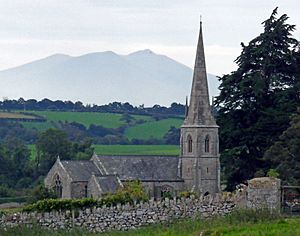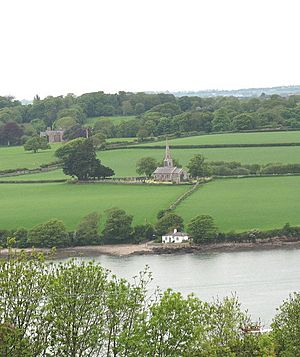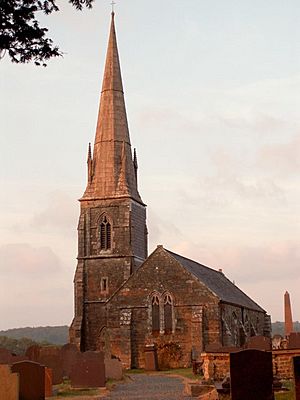St Edwen's Church, Llanedwen facts for kids
Quick facts for kids St Edwen's Church, Llanedwen |
|
|---|---|

The north side of St Edwen's
|
|
| Lua error in Module:Location_map at line 420: attempt to index field 'wikibase' (a nil value). | |
| OS grid reference | SH 517 682 |
| Location | Llanedwen, Anglesey |
| Country | Wales, United Kingdom |
| Denomination | Church in Wales |
| Website | Parish website |
| History | |
| Status | Parish church |
| Founded | 640; current building 1856 |
| Founder(s) | St Edwen |
| Dedication | St Edwen |
| Architecture | |
| Functional status | Active |
| Heritage designation | Grade II |
| Designated | 23 April 1998 |
| Architect(s) | Henry Kennedy |
| Architectural type | Church |
| Style | Late Decorated |
| Specifications | |
| Materials | Rubble masonry with red gritstone |
| Administration | |
| Parish | Bro Dwynwen |
| Deanery | Synod Ynys Mon |
| Archdeaconry | Bangor |
| Diocese | Diocese of Bangor |
| Province | Province of Wales |
St Edwen's Church in Llanedwen is a beautiful church built in the 1800s. It is located near the Menai Strait in Anglesey, north Wales. The very first church here was started by St Edwen in the year 640. She was the daughter of King Edwin of Northumbria. The church you see today was built in 1856. It was designed by Henry Kennedy, who was an architect for the Diocese of Bangor.
Inside the church, you can find old memorials from the 1600s and 1700s. There is also a special reading desk that uses old wooden panels from the 1300s and 1600s. A famous historian from the 1700s, Henry Rowlands, used to be the vicar here. He is buried in the churchyard. The church is on land that belongs to the Plas Newydd estate. This estate has been the home of the Marquess of Anglesey family since 1812. Today, the National Trust owns it. Some members of the Marquess's family and their workers are also buried in the churchyard.
St Edwen's Church is used for worship by the Church in Wales. It is one of seven churches in a group called a combined parish. Every Sunday morning, a service is held using the Book of Common Prayer. St Edwen's is special because it is one of the few churches in Wales that is still lit only by candles. It is also a Grade II listed building. This means it is a building of special interest that should be protected. People think it is a great example of Henry Kennedy's design for a small church in the countryside.
Contents
Church History and Location
St Edwen's Church is in the southern part of Anglesey, north Wales. It is in a countryside area called Llanedwen. The church is about 5 miles (8 km) from the main town of Llangefni. It is also about 1 mile (1.6 km) from the A4080 road. This road connects Llanfairpwllgwyngyll and Brynsiencyn. The church is only about 250 meters (270 yards) from the Menai Strait. This is the narrow body of water that separates Anglesey from the rest of Wales.
The church is on land that is part of the Plas Newydd estate. This estate has been the home of the Marquess of Anglesey family since 1812. Some of the former marquesses and their employees are buried in the churchyard. The National Trust now owns Plas Newydd and its grounds. The name Llanedwen comes from the church. The Welsh word llan first meant "enclosure" and then "church."
The First Church and St Edwen
According to a historian from the 1800s, Angharad Llwyd, the first church in this area was built by St Edwen in 640. We do not know much about Edwen's life. However, old writings say she was the daughter or niece of Edwin of Northumbria. He was a king who became a Christian in 627. After he died in 633, people honored him as a saint. A writer from the 1100s, Geoffrey of Monmouth, wrote that Edwin was born in north Wales. His mother was staying there with Cadfan ap Iago.
Changes Over Time
In 1833, Angharad Llwyd described the church as "a small but neat building, very old." In 1840, the church was rebuilt by John Welch. In 1847, a clergyman named Harry Longueville Jones said St Edwen's was in the Early Perpendicular style. He noted that its windows had been changed. The church measured 52 feet (16 meters) by 16 feet (4.9 meters).
Sir Stephen Glynne, a Welsh politician, visited in May 1850. He called it "a very small church in a lovely situation." He also said it had "a beautiful view over the Menai."
In 1856, the church that these people saw was taken down. The church building that stands today was then built. It was designed by Henry Kennedy, the architect for the Diocese of Bangor. Only some of the stone at the bottom of the west wall from the old church remained. Some repair work was done in 1956.
Church Services and People
St Edwen's is used for worship by the Church in Wales. It is one of seven churches in a group called Bro Dwynwen. A service is held every Sunday morning. It uses the 1662 Book of Common Prayer. There are no services during the week. The church is part of the Synod Ynys Mon deanery. It is also part of the Bangor archdeaconry and the Diocese of Bangor. As of 2025, the main priest is Reverend E Roberts. Canon Professor Leslie Francis is the associate priest.
Many people have been connected to the church. Henry Rowlands was a vicar here in the early 1700s. He wrote a history of Anglesey called Mona Antiqua Restaurata in 1723. He is buried in the churchyard to the west of the door. His tombstone has a Latin message. It says: "All things are nought save what he gave to needy ones. These have force when arts perish and writings fall to pieces." William Bulkeley Hughes, who lived in the area, died in 1882. He was a Member of Parliament for 40 years. He is also buried in the churchyard. The churchyard also has one Commonwealth war grave. It belongs to an officer from the First World War.
Church Design and Features
St Edwen's is built from local red gritstone. This stone is shaped into square blocks. Sandstone is used for the finishing touches. The roof is made of slate with stone edges. The church is built in the Late Decorated style. It has a tower with a pointed roof called a broach spire at the north-west corner of the main part of the church, called the nave. This tower is supported by strong buttresses.
You enter the church through a porch with an arched doorway. This is in the lowest part of the tower. Inside, you can see the wooden beams of the roof. Some of the wooden beams in the nave might be old ones reused from the 1856 rebuilding. The nave and the chancel (the area near the altar) are separated by an arch. Three steps lead up from the nave to the chancel. The chancel and the sanctuary (the area around the altar) are separated by a rail. This rail sits on top of some wooden panels.
Windows and Stained Glass
There are two windows in the west wall. They have special stone patterns called tracery. The stained glass in these windows shows scenes from the Bible and geometric shapes. Birds like the phoenix and peacock are shown at the top. This glass is dedicated to Rice Robert Hughes, a clergyman who died in 1801.
There are three arched windows in the south wall of the nave. The stained glass in the window furthest east shows Bible scenes. This window is dedicated to William Bulkeley Hughes. The window furthest east in the north wall of the nave is dedicated to Thomas Bulkeley Hughes (who died in 1836), his wife, and children. The chancel has one window in the east wall. This window has three sections, called lights, separated by stone mullions.
Pulpit, Pews, and Other Items
The pulpit has some oak panels from the 1800s. It also reuses some fancy panels from the 1600s. These old panels are decorated with pictures of cherubs, dragons, dogs, and lions' heads. The pews, where people sit, are made of pine wood. The choir stalls also have some carved oak panels that might be from the 1600s. A reading desk from the 1800s uses older materials from the 1300s and 1600s. It shows a lion, a griffin, and angels. The church also has an eight-sided sandstone font. This is a basin used for baptisms, and it has a carved cross.
In 1937, a survey found seven memorials from the 1600s and 1700s inside the church. The oldest one was for Thomas Owen, who died in 1646. The tombs in the churchyard include one for Sidney Griffith (died 1618). There are more than 20 other tombs from the 1600s and 1700s. The survey also noted some oak dog tongs, likely from the 1800s, and three chairs from the 1600s.
A survey of church items in 1906 found an engraved chalice (a cup) from 1842. It also found a paten (a small plate) from 1776–77. Both are made of silver and have leaf designs. A silver flagon (a large jug) has an inscription. It says it was given by William Bulkeley Hughes when the new church was dedicated in 1856. The survey also noted a flagon from about 1700 and a dish, both made of pewter. St Edwen's is one of the few churches in Wales that is still lit only by candles.
Why St Edwen's is Special

St Edwen's Church is recognized nationally and protected by law. It is a Grade II listed building. This is the lowest of the three grades, meaning it is a "building of special interest." It was given this status on April 23, 1998. It is listed because it is seen as "a good example of H Kennedy's designs for a small-scale rural church." Cadw, the Welsh Government body that protects Welsh heritage, also notes the church's features. They mention the "fine carved work of the 14th and 17th centuries" inside.
In 1908, Sabine Baring-Gould wrote that the rebuilt church was "wholly devoid of interest." However, a 2009 guide to buildings in the area noted that the Incorporated Church Building Society (active in the 1800s) thought Kennedy's design was "inconsistent with the gravity of feeling which pervades the ancient churches of Wales."
Harry Longueville Jones wrote in 1847 that the churchyard was "one of the most interesting in Anglesey." He liked its beautiful look and location. A 2006 guide to Anglesey churches describes St Edwen's as "a good example of an unspoilt 19th century country church." It adds that the church has "little changed since it was built." The guide says it is in a "tranquil spot" and is a landmark "visible from a considerable distance."


